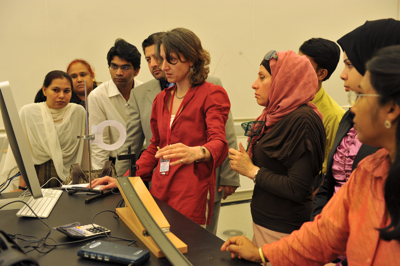Local Professors Get a Fresh Perspective on Teaching Physics
April 2010

Julie Nucci, PhD, takes local high school students through an
exercise involving model stunt cars to explore velocity and acceleration.
Forty-five science teachers came to WCMC-Q and became students again, racing tiny cars and calculating the physics of rock climbing.
They were participants in WCMC-Q’s second annual physics workshop for local high school teachers led by two internationally known physics teacher trainers—Julie Nucci, PhD, and Jim Overhiser— from Cornell University’s Center for Nanoscale Systems Institute for Physics Teachers who guided them through interactive lectures and experiments over two days in lecture halls and labs around the college. The goal was to involve the teachers in hands-on activities to help them engage their students on a deeper level.
“This workshop exposes the teachers to new approaches and to the resources we have at WCMC-Q,” said Syed Ahmed Hasnain, senior physics lab assistant. “Part of our mission is to connect with and support the local community here.”
Over the course of the workshop, the teachers participated in labs involving model stunt cars and ramps to explore velocity and acceleration; light bulbs to explore luminosity, and metal springs with weights suspended with suction cups from white boards to analyze the physics of rock climbing and the forces on the human body.
Working with a grant from the National Science Foundation, Nucci—the director of education programs at the Center for Nanoscale Systems Institute for Physics Teachers and head of the CNS Institute for Physics Teachers (CIPT) at Cornell, Ithaca—and Overhiser—master CIPT teacher, conduct outreach workshops in New York, around the United States and internationally.
The instructors also held engaging discussions as teachers watched Youtube videos and were prompted to think creatively around the concepts of inertia, centrifugal force and other basic tenants of physics. In one case, the teachers watched a video of a motorcycle jumping over a line of buses. As part of the exercise, the teachers were asked to calculate the width of each bus based only on the physics of projectile motion and the video.
“I grabbed four teachers and arranged it so they were sitting in four chairs spaced like the seats of a bus,” Overhiser explained. “I told them ‘you’ve been on a bus, you know how to find the answer to this one.’”
The teachers were given a handout describing how each of the labs and internet-based activities correspond to the standards set out by Qatar’s Supreme Education council. They expressed excitement about being able to incorporate new material into their classes.
“This has been quite interesting,” said Binda Abraham, a physics teacher at Al Bayan secondary school. “We received so many tips to create more interest in the students and we look forward to coming back and learning more in the future. The websites will be very useful.”
The real skill of physics is being able to take a big problem and distill it down into smaller problems; that is worth much more than being able to spit out Newton’s laws,”Nucci said.
The program has grown since last year—from 17 participants to 45—and Hasnain said he looks forward to building relationships with more schools in the future.
“After last year’s workshop, the teachers called me a lot and I have been visiting their schools to teach them new labs and help them pick up more ideas,” Hasnain said. “We are really grateful for the chance to work with and positively affect the local community—the Qatari teachers and the Qatari students.”
The physics outreach will continue all year long and is improving this year as WCMC-Q prepares an equipment lending library—complete with all of the experiments that Nucci and Overhiser have conducted so far. The library will allow local high school teachers to rent equipment for use in their classrooms. Teachers would, for instance, be able to rent kits with mini stunt-cars and ramps to help their students get an experience of velocity and acceleration.
“We know these things, we just want to know how to apply them directly,” said Amina Amir, a physics teacher at Al Bayan Secondary School. “I wasn’t sure before, but now I am thinking about how I can introduce projectile motion next year.”
Report By: Emily Alp
